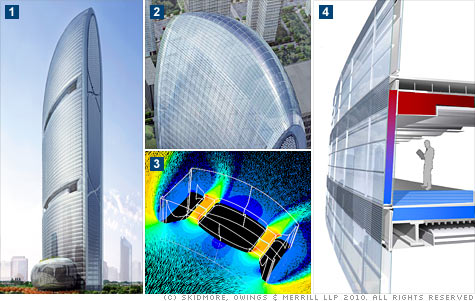 1. The Pearl River Tower 2. Solar roof panels 3. Power-generating wind turbines 4. Capturing heat from the sun
1. The Pearl River Tower 2. Solar roof panels 3. Power-generating wind turbines 4. Capturing heat from the sun(Fortune Magazine) -- The Holy Grail of modern architecture is to design a zero-energy building, or ZEB.
ZEBs use solar, wind, and geothermal systems to produce at least as much energy as they tap from the grid. In some cases, a building's owner can sell the excess electricity generated by the structure back to its utility, reducing overall demand for power generated by coal and other greenhouse-gas-emitting plants.
Yet ask any architect and you'll get an earful on the design challenges of ZEBs. (Skyscrapers don't have much roof space for solar panels, for example.) In fact, there are only eight nonresidential ZEBs in the U.S. -- all of them tiny.
That didn't deter Chicago-based architecture firm SOM from trying. It designed the Pearl River Tower, a 71-story skyscraper in Guangzhou, China, that will open this fall.
China National Tobacco, the owner, wanted a ZEB for its energy cost savings (Pearl River will be 58% more energy efficient than conventional skyscrapers) and the green cred.
SOM did run into some obstacles. For one, the building was meant to have a geothermal system, but the site didn't generate enough warm ground water for it to work. Even so, when the building is fully operational, says SOM, it will be the world's most efficient skyscraper.
What Gives the Tower Power
Keeping cool. Tall buildings use most of their energy trying to keep their inhabitants cool. Even in cold climes, towers run their AC systems most days of the year to counteract the heat from lighting, computers, and workers.
Solar panels on Pearl River's roof (see image No. 2, above) provide power to perforated metal window blinds that automatically track the sun and open and close to minimize solar heat.
Tapping free fuel. Pearl River isn't the first tower to sport electricity-generating wind turbines. What's unique is that its helical turbines (image No. 3), which are inside four openings on the skyscraper's face, will generate power in relatively mild winds from multiple directions.
The turbines, tested in winds as high as 140 mph, will generate up to 4% of the building's power.
Beauty is skin deep. The exterior walls of Pearl River hide an eight-inch air gap inside them (image No. 4). When the sun beats through the double-glazed outer skin, the heat -- instead of entering the interior -- is trapped in this cavity and then rises to heat exchangers on the equipment floors. This, with other features, lets the building use an AC system that is 80% smaller than those in conventional skyscrapers. ![]()






| Company | Price | Change | % Change |
|---|---|---|---|
| Ford Motor Co | 8.29 | 0.05 | 0.61% |
| Advanced Micro Devic... | 54.59 | 0.70 | 1.30% |
| Cisco Systems Inc | 47.49 | -2.44 | -4.89% |
| General Electric Co | 13.00 | -0.16 | -1.22% |
| Kraft Heinz Co | 27.84 | -2.20 | -7.32% |
| Index | Last | Change | % Change |
|---|---|---|---|
| Dow | 32,627.97 | -234.33 | -0.71% |
| Nasdaq | 13,215.24 | 99.07 | 0.76% |
| S&P 500 | 3,913.10 | -2.36 | -0.06% |
| Treasuries | 1.73 | 0.00 | 0.12% |
|
Bankrupt toy retailer tells bankruptcy court it is looking at possibly reviving the Toys 'R' Us and Babies 'R' Us brands. More |
Land O'Lakes CEO Beth Ford charts her career path, from her first job to becoming the first openly gay CEO at a Fortune 500 company in an interview with CNN's Boss Files. More |
Honda and General Motors are creating a new generation of fully autonomous vehicles. More |
In 1998, Ntsiki Biyela won a scholarship to study wine making. Now she's about to launch her own brand. More |
Whether you hedge inflation or look for a return that outpaces inflation, here's how to prepare. More |